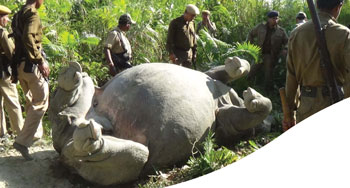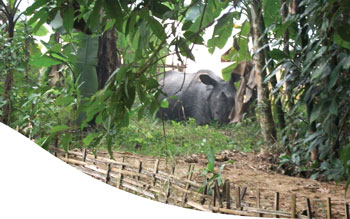Archives
Hunted
Amid nonstop rhino slaughter not everyone remained voiceless onlookers and this was due to the ceaseless anti - poaching drive by a selected team of police officers operating from the neighbouring Karbi Anglong district. More than 60 suspected poachers have been put behind bars and a huge quantity of arms and improvised assorted weapons were seized from concealed places during 2011-12.

Mention may be made of Inspector Naba Bora, Sub Inspector Manirul Islam and Mobilic Bramha; the other officials are Additional Superintendent of Police Bolin Deuri and the then Superintendent of Police BB Cherti. This team not only operated against the organized gang of international smugglers but also fought against departmental officers and staff and also political leaders who corroborated with poachers and dealers linked with China and other South East Asian countries in smuggling rhino horns through various safe routs. The detained includes members of trigger happy extremist outfits and professional poachers settled in the fringe areas of Kagiranga Park. The valiant efforts of this police force had to be halted when the interests of high level police officers and an Assam Cabinet Minister collided with these efforts. These people went out of their way to throttle the initiative. Suspected Bangladeshi immigrant poachers operating from hideouts in Nagaon district were shielded from the special police team by an influential incumbent Minister of Assam and the arrested persons slipped through the loopholes of the legal net by obtaining easy bail. Nevertheless, cases are continuing under the Indian judicial system. Although the Assam Government claims that not less than 300 armed poachers are on the prowl around the park and are equipped even with AK-series assault rifles, the police force of the locality has never proactively acted against these elements.
Although the swamps of Kagiranga are the natural breeding grounds of the one horned rhino, the safe sanctuary of these wonderful beast is the highland across the national highway, an area of about 800 square kilometers controlled by Northern Range Dolamara and North West Range Parkup Pahar both in the eastern flank of Karbi Anglong district bordering the Nagaon and Golaghat districts of Assam. When whole flood plains of the park are submerged from June to August not only the rhinoceros but other large animals and reptiles scale the high ridge areas covered by Northern Range Dolamara and North West Range Parkup Pahar administered by East Division Forest under Karbi Anglong Autonomous Council.
| Poachers operating from hideouts in Nagaon district were shielded from the special police team by an influential incumbent Minister of Assam |
Northern Range Dolamara encompasses an area of 421 square kilometers approximately compared to Kaziranga Park’s 810 square kilometres (roughly) area conveniently administered by five range officers packed with security personnel armed with SLR and armed home guards, these ranges have all kind of logistics for surveillance, rescue and repealing attacks of poachers. The entire national park is under the scanner of the police. Paradoxically the Dolamara and Parkup Pahar ranges of Karbi Anglong which shelter the animals of Kagiranga during the critical hour are hardly protected in the truest sense of the term.
| Bizarrely enough with massive protection in place, poaching of rhinos is still rampant inside the core areas of Kaziranga Park where the rhino concentration is the highest in contrast of the record of poaching inside any of the two forest ranges of Karbi Anglong |
For instance Dolamara is administered by a Range Officer and his Deputy Ranger supported by twelve Foresters and ten Forest guards and about twenty five temporary labourers. Besides this, a few members of the office staff assists the Range officer in protection duty. Although the authority desperately needs armed home guards and a special forest protection force and other logistics to combat the ever increasing challenges of the poachers especially rhino rustlers; this range does not have any armed force to deal with poachers; even as the protection of the forest ranges adjacent to Kaziranga is essential for the animals of the sanctuary which migrate to this areas for safety during the critical spell.
 “We have nine .315 rifles and two 12 bore shotguns beside two SUVs (Bolero), wireless sets provided by the authority which help us to some extent; we need trained professionals to use arms, we have other duties besides providing protection round the clock. Plantation and management of non - timber forest products, guarding against timber smuggling are other big tasks we have to look after every day, an ambitious project like the bamboo mission has no doubt helped the forest department in reaching the people who reside in the fringe areas of reserve forests, in fact they help us in management and protection of the forests but we need a total revamp of the system. With a handful of staff not trained in combat it is indeed a challenge to protect an area spread over 400 square kilometers in all weather; but till now we have succeeded in minimizing wildlife poaching in contrast to other places; in our endeavour the local people and especially the media professionals help us a lot. In my area several measures were adopted since 2009 for the protection of wildlife in narrow level; for this purpose gaining the confidence of the local people is the key factor” P. Kro serving Range officer of Dolamara range said.
“We have nine .315 rifles and two 12 bore shotguns beside two SUVs (Bolero), wireless sets provided by the authority which help us to some extent; we need trained professionals to use arms, we have other duties besides providing protection round the clock. Plantation and management of non - timber forest products, guarding against timber smuggling are other big tasks we have to look after every day, an ambitious project like the bamboo mission has no doubt helped the forest department in reaching the people who reside in the fringe areas of reserve forests, in fact they help us in management and protection of the forests but we need a total revamp of the system. With a handful of staff not trained in combat it is indeed a challenge to protect an area spread over 400 square kilometers in all weather; but till now we have succeeded in minimizing wildlife poaching in contrast to other places; in our endeavour the local people and especially the media professionals help us a lot. In my area several measures were adopted since 2009 for the protection of wildlife in narrow level; for this purpose gaining the confidence of the local people is the key factor” P. Kro serving Range officer of Dolamara range said.
Although the Assam Government has amended the existing Wildlife Protection Act which has empowered the judiciary to award a life sentence to any poacher if proved guilty, this Act has now given the power to the forest officers and staff to go all out against the poachers even as a new amendment has made it compulsory for police to seek prior permission of the Government before prosecuting any forest official on duty, this has been made clear in the section 197 CRPC. Moreover a maximum offense in violation of the Wildlife Act is now punishable by a non-bail able offense according to the new amendment. However the ground level implementation of the Act wholly depends on the sincerity of the authority at the apex level. Even as age old bolt action lee en-field rifles of 303 caliber have been replaced by self loading automatic rifles for the officials of Kaziranga, their Karbi Anglong counterparts are waging a grim battle against the same poachers without even a single armed home guard not to speak of any specialized force. Bizarrely enough with massive protection in place, poaching of rhinos is still rampant inside the core areas of Kaziranga Park where the rhino concentration is the highest in contrast of the record of poaching inside any of the two forest ranges of Karbi Anglong which is very negligible.

